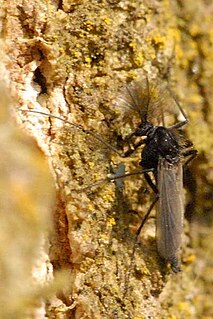Related Research Articles

Bryan Lee Cranston is an American actor, director, producer, and screenwriter. He is best known for his roles as Walter White in the AMC crime drama series Breaking Bad (2008–2013), Hal in the Fox sitcom Malcolm in the Middle (2000–2006), Tim Whatley in the NBC sitcom Seinfeld (1994–1997), and Vince Lonigan in the Prime Video crime drama series Sneaky Pete (2015–2019).

The Chironomidae comprise a family of nematoceran flies with a global distribution. They are closely related to the Ceratopogonidae, Simuliidae, and Thaumaleidae. Many species superficially resemble mosquitoes, but they lack the wing scales and elongated mouthparts of the Culicidae. An example of mosquito-resembling species is Tokunagayusurika akamusi.
Antillocladius is a genus of midges belonging to the family Chironomidae, subfamily Orthocladiinae. The name Antillocladius means orthoclad that occurs in the Antilles, where it was primarily recorded.

The genus Axarus is widely distributed with records from the Holarctic, the Neotropics and Australasia . There are currently 5 described nearctic species . Erected as a subgenus (Anceus) of Xenochironomus , Axarus was subsequently renamed and elevated to generic status . The Connecticut River in the eastern United States harbors locally dense populations of two Axarus species, both currently undescribed. These populations are interesting in that they are restricted to specific larval habitat and thus there is genetic structure between populations in the river . The Connecticut River species are also notable in that they have extremely well developed polytene chromosomes and also maintain a high degree of inversion polymorphism .

Kealia Pond National Wildlife Refuge is a coastal salt marsh along the south-central coast of the Hawaiian Island of Maui. The refuge is located between the towns of Kīhei and Māʻalaea, on both sides of North Kihei Road, Route 31. The wetland is also a 691-acre (2.80 km2) bird sanctuary, home to 30 species of waterfowl, shorebirds, and migratory ducks, including the ʻaukuʻu and the endangered āeʻo and ʻalae kea. Kealia Pond was selected as a wildlife refuge in 1953, protecting an initial 300 acres (1.2 km2) of land. The refuge joined the National Wildlife Refuge System in 1992.
Acamptocladius is a genus of non-biting midges in the subfamily Orthocladiinae of the bloodworm family Chironomidae.
Australopelopia is a genus of non-biting midges of the bloodworm family Chironomidae.
Apometriocnemus is a genus of non-biting midges in the subfamily Chironominae of the bloodworm family Chironomidae.
Halocladius is a genus of halophilic, non-biting midges in the subfamily Orthocladiinae of the bloodworm family (Chironomidae). They inhabit seashores and saline inland waters of the Northern Hemisphere. Wing length is 1.5–3.5 mm (0.06–0.14 in). Two subgenera have been described: Halocladius and Psammocladius.

Metriocnemus is a genus of non-biting midges in the subfamily Orthocladiinae of the bloodworm family Chironomidae.

Tanytarsus is a large genus of non-biting midges of the tribe Tanytarsini and subfamily Chironominae of the bloodworm family (Chironomidae). The larvae of these insects occur in a wide range of freshwater habitats with some species being marine.

Chironominae is a subfamily of midges in the non-biting midge family (Chironomidae).

Chironomini is a tribe of midges in the non-biting midge family (Chironomidae).

Polypedilum is a genus of non-biting midges in the subfamily Chironominae of the bloodworm family Chironomidae. This is probably the most species-rich of all chironomid genera. Larvae of Polypedilum may also be among the most abundant invertebrates in euthrophic ponds, reaching densities of up to 1200 larvae per square meter.
Cladopelma is a genus of non-biting midges in the subfamily Chironominae and tribe Chironomini of the bloodworm family Chironomidae. Species are distributed world-wide, with species represented in the Palaearctic, Nearctic, Neotropical, Afrotropical, Sino-Indian, and Austroasian regions.
Stictochironomus is a genus of non-biting midges in the subfamily Chironominae of the bloodworm family Chironomidae. Members of this genus often have strongly marked wings and legs. The larvae of these midges may also have distinct dark patterns on the dorsal side of the head capsule. They live in sand and other sediments in a variety of fresh water habitats in densities of several hundred per square meter.

Tanytarsini is a tribe of midges in the non-biting midge family (Chironomidae).

Pontomyia is a genus of flightless marine midges belonging to the subfamily Chironominae in the Chironomidae family. Insects in marine environments are extremely rare while flightlessness, extreme sexual dimorphism, and an extremely short adult life span contribute to making these midges unusual among insects. They are known from the shores of islands in the Indian, Atlantic and Pacific Oceans.
Polypedilum sordens is a species of midge in the family Chironomidae.

Goeldichironomus is a genus of midges in the family Chironomidae. There are about 14 described species in Goeldichironomus.
References
| | This article related to members of the fly family Chironomidae is a stub. You can help Wikipedia by expanding it. |